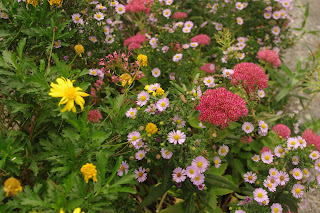A diary of back garden botany, urban ecology, rural rambles and field trips to the middle of nowhere...
Friday, 30 October 2020
Tuesday, 27 October 2020
Another photo taken in Green Park yesterday. The colours of autumn are plain to see but central London is something of a heat bubble and I would say a week or two behind the surrounding region. Daylight hours are the principal "on/off" switch where plants are concerned but temperature, rainfall and general climate have a considerable effect.
Saturday, 24 October 2020
Thursday, 22 October 2020
Tuesday, 20 October 2020
Monday, 19 October 2020
Sunday, 18 October 2020
Friday, 16 October 2020
Tuesday, 13 October 2020
I noted recently that cardboard is excellent for suppressing unwanted vegetation and lasts for several months before biodegrading. So I was happy to accept the offer of a pile of boxes from a recent house move. Couch grass is pervasive on the allotments. It would need to be covered at least a year or two to get rid of it but hopefully the cardboard will knock it back a bit. And a good way to "draw" the layout of the paths.
Sunday, 11 October 2020
Thinking back on the year in an autumnal sort of way. I posted this photograph on 1st. January with the caption "Time and tide, North Kent coast". Little did I know what the year had in store.
I remember walking among the Wild Daffodils and Wood Anemones at Lesnes Abbey in mid-March. The implications of Covid and the proposed lockdown were just starting to sink in. And yet the springtide was glorious.
Needless to say rural rambles were put on hold. But that did focus my attention on things closer to home. For example I saw a fine display of Wild Clary on Windmill Hill in Hitchin (my home town). I have walked over Windmill Hill many times in my life. Somehow I have never noticed these drifts of blue before!
Likewise there were no field trips to the middle of nowhere. Instead I revisited some familiar landscapes like the Pegsdon Hills and Knocking Hoe where the Chilterns escarpment meets East Anglia. Familiar but always new.
Nature and fine summer days were certainly a great consolation. Summer turns to autumn, autumn turns to winter, winter heralds spring. Time and tide.
Friday, 9 October 2020
Wednesday, 7 October 2020
Monday, 5 October 2020
Sunday, 4 October 2020
The previous year I hiked a section of the PCT where it skirts around Crater Lake in Oregon. I came upon a section of the forest that been decimated by fire a number of years ago. None the less nature was renewing itself from the ground up.
Wildflowers were carpeting what was previously the forest floor. The tree canopy would have shaded out this kind of growth but the soil is a repository of seeds waiting to germinate when conditions allow. It's worth bearing in mind that this part of the world has a fire ecology. It has always burned and always will and the endemic species have adapted to this over millennia.








































